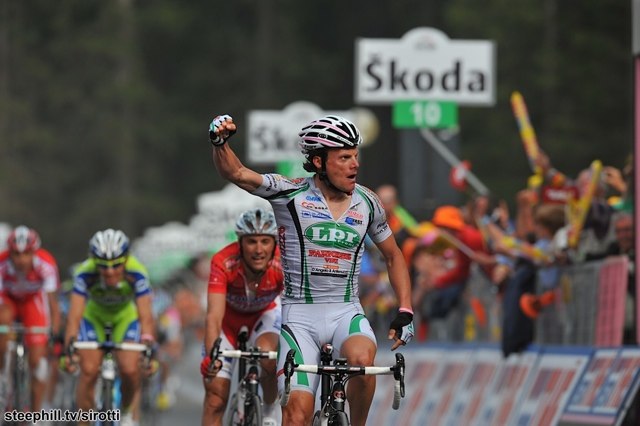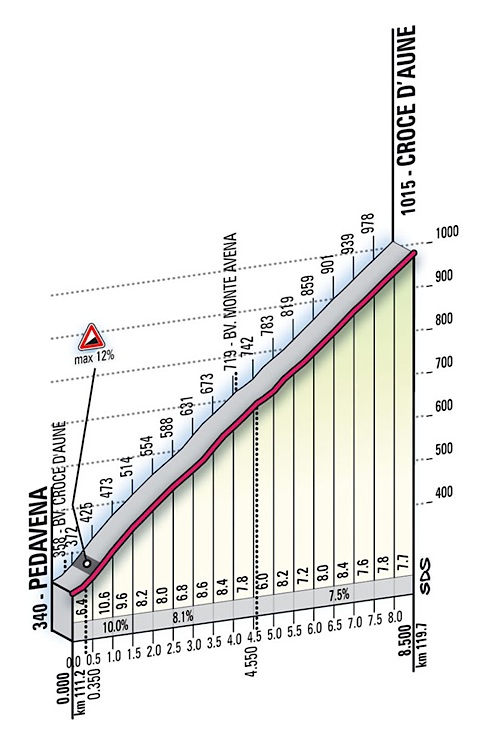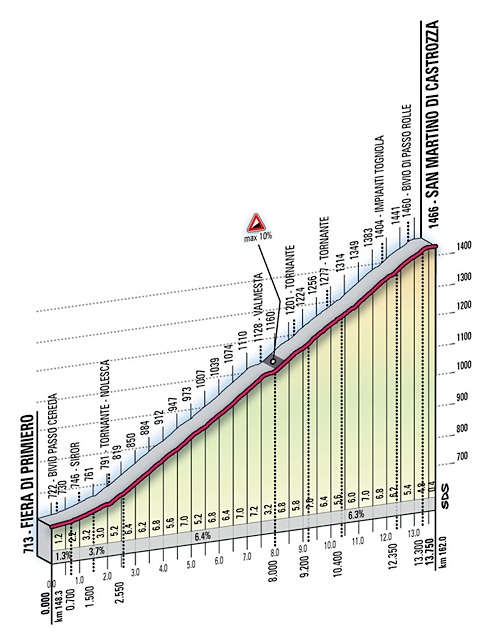
 | « steephill.tv home • |
| « Stage 03 | Return to Giro d'Italia 2009 Live Dashboard | Stage 05 » | ||||||||||||||
|
profile | map | timetable | preview | results | photos | video Post Stage AnalysisStage 4 post-race analysis: Fast and Furious: Diluca Wins! 
May 12 update: The Giro Centenario headed into the mountains today, for the first uphill finish. As mountain stages go, this one was not especially difficult and a large group survived to contest the finish. Over the first climb of the day, the Croce d'Aune, the sprinters gruppetto formed, and Aleassandro Petacchi conceded the race lead. By the base of the final climb of the day to San Martino di Castrozza, the pink jersey sat 8 minutes behind the main field. Up front, the race for the stage win and the general classification was on. A three rider break, including Jens Voigt of Saxo Bank, Francesco De Bonis of Diquigiovanni-Androni, and Francesco Bellotti of Barloworld, held around 2 minutes in hand as the climb began. De Bonis quickly went out the back, while Bellotti and Voigt continued onward. Behind the break, LPR Brakes, the team of Danilo Diluca drove the pace, in an effort to set up their team leader for the stage win and a possible run for the leader's jersey. With 10 kilometers to go, the gap was 1.54. With 8 kilometers to go, Jens Voigt decided to go it alone and set off up the climb, chasing a solo victory. Behind, Liquigas joined in the chase, steadily chipping away the gap of the flying German. By 6 kilometers to go, the gap had shrunk to 1.15. Climber Juan Mauricio Soler then decided to have a go, and attacked out the main field. Soler is a past winner of the mountains classification at the Tour de France, and he hearts him some climbing. Liquigas redoubled their efforts, bringing Soler back into the fold and shrinking the gap to Voigt. No surrender for the Saxo Bank strongman, and with just under 4 kilometers to ride, Voigt still held 30 seconds. The gradient steepened, but not enough to break the momentum of the charging field. The bunch swept through the wide corners under a canopy of pines. Led by Liquigas, the field stretched out, the tempo too high to allow any real attacks. Just inside 3 kilometers to ride, the field finally caught Voigt. Gruppo compatto. With 2 kilometers to go, Soler went again. Sylwester Szmyd of Liquigas continued the chase, before deciding to give the other teams a chance. The brief hesitation in the bunch nearly allowed Soler's cheeky attack to succeed. Inside the last kilometer, Danilo Diluca took charge. Diluca said yesterday that he would try to win this stage and today he made good on his promise. Almost instantly, he closed the gap to Soler, with Stefano Garzelli on his wheel. Garzelli could not come around, and it was all Diluca on the line. Today marked Diluca's 27th victory in his career, and his first stage win in the Giro since Briançon in 2007, the year he also won the overall classification. After the stage, Diluca told Alessandra De Stefano of RAI, "This was my finish. I believed in it, and I asked my team to work all day to bring back the breakaway. You can say that I earned this victory. I have said that today and tomorrow I need to try to gain ground and I have done it today, tomorrow, I will try again." Diluca also dedicated his victory to the people of Abruzzo, his home region. The former Giro winner is raising money throughout this Giro to help rebuild after the recent earthquake in Aquila, which is in the Abruzzo region. When asked if he wanted to say hello to anyone specific, he laughed and said, "Ciao a Tutti," hello to everyone! General Classification Update The Maglia Rosa of race leader passes to Thomas Lövkvist of Columbia-High Road. He becomes the third Swedish rider to wear the Pink Jersey, following Gösta Petterson and Tommy Prim. Lövkvist, who currently also leads the young riders' classification, said after the stage, "I didn't expect to make it to the finish, but I had very good legs." The young Swede was working for Michael Rogers, but in the finale Rogers had a bit of bad luck and was delayed in the finale. Unfortunately, the cameras did not catch the incident, but Rogers reported later that he had to clip out to avoid crashing. In other general classification news, Lance Armstrong did not contest the sprint and conceded 15 seconds at the line. Here are the current overall situation among the favorites: Abandons. Francisco Perez Sanchez of Caisse d'Épargne crashed out today after 11 kilometers of racing. Early reports say that he has broken ribs, but the team has not released any details just yet. Game on for the Climbers! Mountains are the theme again tomorrow, and by all accounts, the final climb of the day should open up time gaps among the favorites. Expect a "gruppo ristretto," a small group, to contest the finish. We may also see a new race leader. The final climb of the day, the Alpe di Siusi, is 25 kilometers in length, with an average gradient of 6%. The climbers will need to ride here, as they will want time in hand before the Giro reaches the long crono at Cinque Terre. Diluca has already promised he will light it up again tomorrow. This is also Gilberto Simoni country, and according to his directeur sportif Gianni Savio, the climber from Trentino will "be a protagonist." Stefano Garzelli called tomorrow's stage "real mountains" (as opposed to the fake ones we saw today.) Garzelli says he has good legs, and will certainly try something when the Giro hits the steeper pitches of the Alpe di Siusi. Lampre-Ngc directeur sportif Giuseppe Saronni reports that his team leader Damiano Cunego is riding well. Saronni also commented that "to win the Giro, one needs patience." Wise words from a former Giro winner. As for the new race leader, Lövkvist said there would be no gifts tomorrow. The young Swede said that his Columbia-High Road team is "not going to give anything away." He expects an attack from Diluca, who sits 2 seconds behind, and whom he called "very strong." "I'll do what I can, my legs are good," Lövkvist concluded. Forza Lövkvist! Course PreviewStage 4: Padova-San Martino di Castrozza Climbs: Stage 4 begins in Padova (Padua, in English) in the flat lands of Veneto. According to legend, Padova is the oldest city in Northern Italia, its founding story detailed in Virgil’s Aneid. In the flood plain of the Dolomiti, the city sits on the Brenta and Bacchiglione rivers, which feed a network of canals criss-crossing the city. From Padova, the course heads Northwest into the Dolomiti mountain range in the region of Trento. The riders will pass over the 1015 meter Croce d’Aune, before climbing to the finish at San Martino di Castrozza. Just over 1400 meters above sea level, San Martino di Castrozza sits surrounded by jagged Dolomiti peaks. Profile Details. The course travels 40 kilometers of almost entirely flat roads. A short 100 meter bump pops up between kilometers 45 and 47, followed by approximately 20 kilometers of mostly descending terrain. But that’s where the easy part ends. The last 70 kilometers of the stage are all uphill. This stage is about climbing, pure and simple. Croce d’Aune. The first significant climb of the Giro Centenario, the Croce d’Aune comes at kilometer 111. The climb is 8.5 kilometers in length, gains 675 meters in elevation, and has an average gradient of 7.9%. The climb includes a brief section of 12% gradient, just to keep things interesting. The Croce d’Aune is steepest at the bottom, holding between 8 and 10 percent for the first 4 kilometers. The final 4.5 kilometers are at 7.5%. Over the summit, the riders will pass through the village of Aune, a church steeple announces the town. From the top of the Croce d’Aune, there remains 51 kilometers to ride to the finish, 30 km of which are uphill. L’ouch. The Italians designed this Giro Centenario as a celebration of Italian cycling history. At the summit of the Croce d’Aune stands a monument to Tullio Campagnolo. Legend has it that Tullio dreamed up the modern derailleur while climbing the Croce d’Aune. During a 1927 race to the mountain’s summit, the young Campagnolo struggled to change his gears in the cold, rainy weather. The shifting mechanisms at the time (the first derailleurs came from France) did not work especially well when the weather turned wet. By 1930, Tullio had perfected his design for the parallelogram derailleur, the design still used currently, and three years later, Campagnolo opened for business. During the 1980s, company produced a gruppo named “Croce d’Aune,” commemorating the site of Campagnolo’s flash of intuition. It included the distinctive Delta brake. San Martino di Castrozza. Beginning at kilometer 149, the finishing climb is classic Dolomiti fare. The climbs comes after 20 kilometers of gradual climbing. Somedays, you have to climb to get to the climb. The San Martino di Castrozza is 13.7 kilometers long, rises 753 meters in elevation, and has an average gradient of 5.5%. The average is a bit misleading. The opening kilometers have a gentle gradient, between 1 and 3%. Around kilometer 3, the gradient jumps up to 6.4%, where it remains for most of the remaining kilometers. The maximum gradient of 10% occurs with about 5 km to go to the finish, and might offer an ambitious rider the chance to escape. The final kilometers have a gradient of 6.3%. Tactics Talk. The road to San Martino di Castrozza is wide and smooth with broad sweeping corners. Little wonder there is an annual rally car race held on this road. A strong team could do damage on a climb like this, or alternatively, ensure that no one dangerous sneaks away. Because this stage comes so early in the Giro, many riders will hit the climb with fresh legs and it may not create the kind of time gaps that it otherwise would. The favorites may well choose to play stare-down, rather than go on the attack. There is opportunity on the slopes of the San Martino di Castrozza, but it’s still a long way to Roma. 
The Finish Profile
— Gavia (updates to this preview will be made during the race and especially the day before the stage with current analysis)
|
|
||||||||||||||